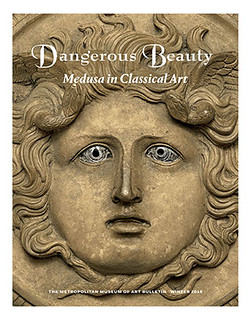
PREV ARTICLE
NEXT ARTICLE
FULL ISSUE
PREV FULL ISSUE
ANS COINS FEATURED IN MUSEUM EXHIBITSLast week we pictured a Gorgon Face Parion Hemidrachm in Frank Robinson's sale. Coins from the American Numismatic Society collection are part of an exhibit now on view at
the Metropolitan Museum of Art about "Medusa—the snaky-haired Gorgon whose gaze turned men to stone". Here's a note about the exhibit from the February 2018 ANS E-News.
-Editor
Dangerous Beauty: Medusa in Classical Art Beginning in the fifth century BC, Medusa became increasingly anthropomorphic and feminine, undergoing a visual transformation from grotesque to beautiful. "Dangerous Beauty: Medusa in Classical Art," featuring a number of ANS coins, explores how the beautification of terrifying figures like Medusa, sirens, and other female half-human beings manifested in the idealizing humanism of Classical Greek art, and their enduring appeal in both Roman and later Western art. Here's the exhibit overview from the Met web site. -Editor
The connection between beauty and horror, embodied above all in the figure of Medusa, outlived antiquity, fascinating and inspiring artists through the centuries. Medusa became the archetypical femme fatale, a conflation of femininity, erotic desire, violence, and death. Along with the beautiful Scylla, she foreshadows the conceit of the seductive but threatening female that emerges in the late 19th century in reaction to women's empowerment. For more information on the exhibit, see: The Horse in Ancient Greek Art ANS coins are also on view as part of an exhibit at the Virginia Museum of Fine Arts. -Editor
The Horse in Ancient Greek Art presents imagery of mythical horses like the winged Pegasos, who becomes a constellation, as well as horse-hybrids like centaurs and satyrs, creatures that are part human and part horse. Many artists depict chariots, sometimes rushing into battle and sometimes in thrilling races, while others focus on horse races, carefully indicating the goads, bridles, reins, and bits. These images as well as scenes of grooming and feeding well-bred steeds reveal striking parallels between ancient and modern horse care and horsemanship. The Horse in Ancient Greek Art features Greek vases, sculpture, and coins from the 8th through the 4th centuries BC drawn from private collections, the Virginia Museum of Fine Arts, the Tampa Museum of Art, and other museum collections. The exhibition and accompanying publication explore the significance of the horse in ancient Greek culture, and imagery of the horse in ancient myth, war, sport, and competition. From some of the earliest examples of the horse in Greek art, to stunning examples of black and red-figure vases, the objects on view illustrate ancient equestrian life. For more information on the exhibit, see: To read the earlier E-Sylum article, see: For more information about the American Numismatic Society, see:  Wayne Homren, Editor The Numismatic Bibliomania Society is a non-profit organization promoting numismatic literature. See our web site at coinbooks.org. To submit items for publication in The E-Sylum, write to the Editor at this address: whomren@gmail.com To subscribe go to: https://my.binhost.com/lists/listinfo/esylum All Rights Reserved. NBS Home Page Contact the NBS webmaster 
|
